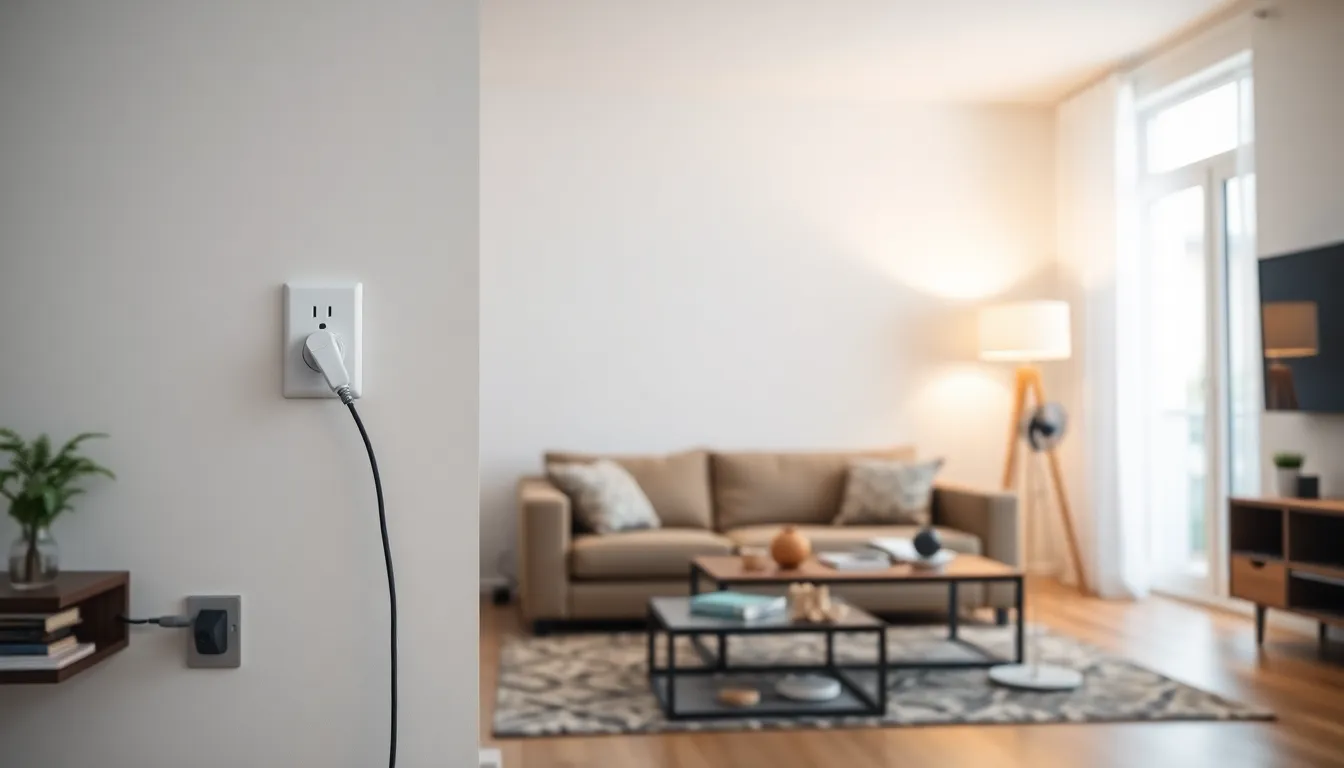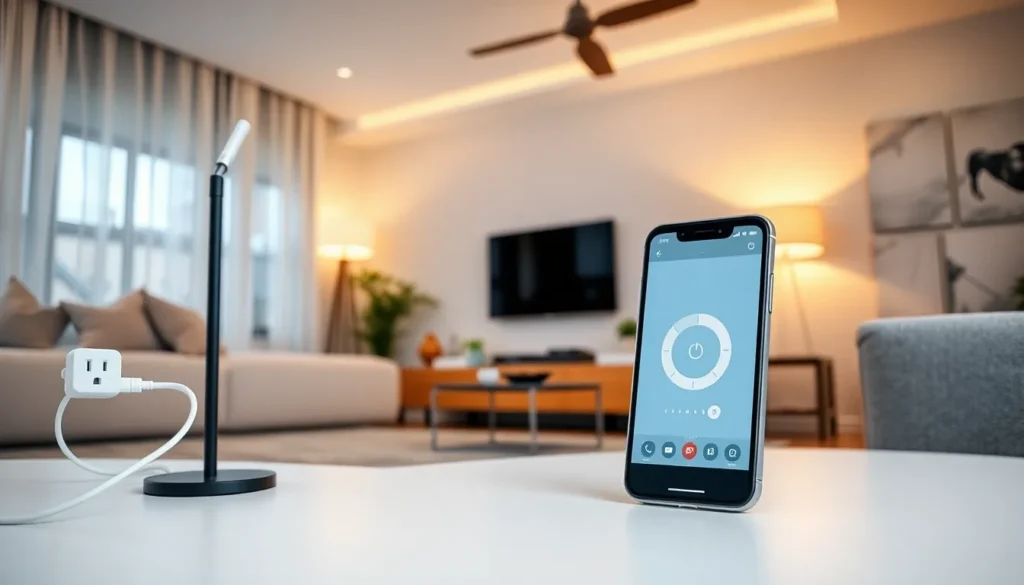Table of Contents
ToggleIn a world where everything seems to be getting smarter, why should plugs be left behind? Smart plug control is the unsung hero of home automation, turning ordinary devices into tech-savvy wonders. Picture this: you stroll into your living room, and with a flick of your smartphone, your lamp springs to life, making you feel like the wizard of your own domain. Who doesn’t want that kind of power?
But it’s not just about showing off your newfound wizardry at dinner parties. Smart plugs save energy, keep devices safe, and can even help you stick to your New Year’s resolutions—sorry, Netflix, but the plug’s got your number! Embracing smart plug control is like giving your home a brain without the need for a PhD in tech. It’s time to plug into the future and unleash the full potential of your devices.
Overview of Smart Plug Control
Smart plugs serve as crucial components in home automation, enabling users to control appliances remotely. These devices connect to Wi-Fi networks, allowing smartphones to communicate with plugged-in devices easily. With a smart plug, turning on or off lights, fans, or other appliances can occur from anywhere.
Energy efficiency stands as a significant advantage of smart plugs. Users track electricity consumption through associated apps, allowing for better energy management. Reducing unnecessary power usage diminishes utility bills while promoting eco-friendly habits. Additionally, scheduling features can automate device operation, further enhancing energy savings.
Safety enhancements come with smart plug use. Many models include built-in surge protection, minimizing risks associated with power surges. Users can also set timers for devices, ensuring that heaters and other appliances do not operate unattended.
Integration with voice assistants marks another key feature of smart plug control. Smart plugs work with Google Assistant, Amazon Alexa, and Apple HomeKit, providing hands-free operation through voice commands. This functionality increases convenience for daily tasks, allowing for effortless interaction with devices.
Furthermore, smart plugs support user goals, like cutting down on screen time. By controlling the operation of entertainment systems, they help establish healthier routines. Users can schedule times to power off devices, fostering a more balanced lifestyle.
Overall, smart plug control embodies a mix of convenience, efficiency, safety, and lifestyle enhancements. Through these devices, people transform their homes into smarter, more connected living spaces.
Benefits of Using Smart Plug Control

Smart plug control offers multiple advantages that enhance home automation and daily living. Users can enjoy increased convenience and improved energy efficiency.
Energy Efficiency
Smart plugs significantly contribute to energy efficiency, allowing users to monitor electricity usage through companion apps. These applications provide insights into consumption patterns and identify high-energy devices. Tracking this data can lead to changes in habits that decrease electricity bills. Automation features enable devices to switch off after a set time, reducing wasted energy when not in use. By identifying and addressing energy consumption, smart plugs promote both cost savings and eco-friendly practices.
Convenience and Automation
Convenience is a key benefit of smart plug control, transforming traditional appliances into smart devices. Users can control lights, fans, and other equipment remotely via smartphones. Voice commands through integrations with Google Assistant, Amazon Alexa, and Apple HomeKit simplify operation. Scheduling features allow users to set timers and automate actions, like turning on lights at sunset. This level of automation minimizes effort and time spent on daily tasks, making life easier and more efficient.
Features to Look for in Smart Plug Control
Smart plugs offer various features that enhance user experience and functionality. Understanding these elements helps in selecting the right device.
Remote Access
Remote access allows users to control devices from anywhere using a smartphone app. Smart plugs connect to Wi-Fi networks, enabling real-time management of appliances. Users can turn devices on or off, set schedules, and monitor energy usage while away from home. Data from these plugs helps users identify high-energy consumption appliances, leading to cost savings. With remote access, users enjoy increased flexibility and convenience in managing household devices.
Voice Control Compatibility
Voice control compatibility is essential for hands-free operation. Many smart plugs work seamlessly with popular voice assistants like Amazon Alexa, Google Assistant, and Apple HomeKit. Users can issue voice commands to control appliances, simplifying daily tasks. Compatibility with these ecosystems enhances convenience, making it easier for users to integrate smart plugs into their existing home automation systems. Voice integration allows for quick and efficient management of various devices, streamlining routines and saving time.
Leading Smart Plug Control Brands
Several brands stand out in the smart plug control market, each offering unique features that cater to different user needs.
TP-Link excels with its Kasa Smart Plug line, known for reliability and user-friendly app integration. These plugs support schedules and timers, helping users automate appliances efficiently.
Belkin and its WeMo Smart Plug provide seamless integration with both Amazon Alexa and Google Assistant. Remote access enhances convenience, enabling users to control devices from anywhere.
Amazon offers its Echo Smart Plug, which works seamlessly with Alexa, making voice control simple and effective. Users can set routines for their devices, contributing to a more automated home environment.
Philips Hue focuses on smart lighting solutions but offers plugs compatible with Hue’s ecosystem. By connecting to the Hue Bridge, users can schedule and control their lighting alongside other devices.
Meross smart plugs offer home automation at an affordable price. Their devices support Apple HomeKit, Google Assistant, and Alexa, allowing for diverse control options in smart home setups.
Gosund provides effective smart plugs known for their energy monitoring capabilities. Users can track power consumption through the app, promoting energy efficiency in their households.
Sengled primarily designs smart bulbs but features plugins to extend home automation systems. Users can manage both lights and appliances under one app interface for ease of use.
Selecting the right brand often depends on individual preferences and existing technology ecosystems. Users benefit from researching compatibility with their current devices and ecosystems to maximize integration and efficiency.
Smart plug control represents a significant leap in home automation technology. By transforming ordinary appliances into smart devices it not only enhances convenience but also promotes energy efficiency and safety. Users can effortlessly manage their appliances from anywhere ensuring a seamless integration into their daily lives.
With the ability to monitor energy usage and set schedules smart plugs empower individuals to make informed decisions about their consumption. This leads to not just cost savings but also a more eco-friendly lifestyle. As the market continues to grow with innovative brands offering diverse features selecting the right smart plug can further enhance the overall experience. Embracing smart plugs is a step toward a more connected and efficient home.







